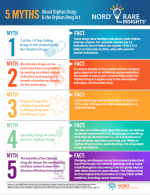The Orphan Drug Act (ODA) was signed into law in 1983 by President Ronald Reagan. This major piece of legislation was the first-of-its-kind for rare diseases and its success has helped to encourage similar legislation in other parts of the world. From the patient perspective, the ODA has been extremely successful, encouraging research and development of orphan drugs – products for diseases that would otherwise be ignored.
Today, there are many misconceptions about orphan drugs and about the Orphan Drug Act. For example, orphan drugs have been tied to rising healthcare costs in America. In 2017, NORD commissioned a study by QuintilesIMS (now IQVIA) to quantify the true impact of orphan drugs on overall healthcare and prescription drug spending. This study found that orphan drugs only accounted for 7.9% of total drug sales.
NORD created the 5 Myths About Orphan Drugs and the Orphan Drug Act series to help dispel some of these myths and to educate stakeholders and decision-makers.
About RareInsights®
RareInsights® is a NORD® initiative to expand public knowledge of rare diseases and translate that knowledge into real-world solutions for patients and families. Through this initiative, NORD is commissioning and undertaking a broad range of projects to collect and analyze empirical data for next-generation advocacy that is patient-centered and data-driven. Information will be shared with the community in a variety of accessible formats, including reports, white papers, infographics, fact sheets, and more.
Resources: 1. QuintilesIMS Institute. Orphan Drugs in the United States: Providing Context for Use and Cost. (2017) 2. National Organization for Rare Disorders. Trends in Orphan Drug Costs and Expenditures Do Not Support Revisions to the Orphan Drug Act: Background and History. (2017)









